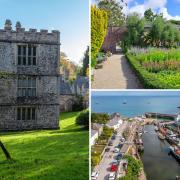The construction of Tate St Ives’ Phase 2 extension is a triumph of mutual cooperation over adversity for all concerned

Now on the verge of fruition, the construction of Phase 2 extension is a triumph of mutual cooperation over adversity for all concerned, discovers MERCEDES SMITH...
When the construction of Tate St Ives was first proposed in the early nineties, the design of its ultra-contemporary building caused some controversy. Most understood, however, that having a division of the world’s most respected art gallery built in St Ives would only add to the town’s established reputation as an historically important art colony. Twenty-one years on Tate St Ives has proved its worth, attracting 200,000 visitors and bringing close to £12 million a year to the regional economy. From its spectacular location on Porthmeor Beach it offers a varied exhibition programme of Modern and contemporary art, while the iconic Evans and Shalev designed building has become an accepted part of the local landscape.
Starting this spring, Tate aim to build on their achievements with the long awaited launch of the Tate St Ives Phase 2 Project. From January 27th to May 17th the gallery will close as work begins on an extension that will double the current gallery space as well as deliver improved visitor facilities, a dedicated area for the display of St Ives Modernist works and new learning and resource centres.

There has, however, been renewed controversy over the Phase 2 project in a town where space, and most particularly resident and visitor parking, is in short supply. When the idea was first mooted in 2004, initial plans were to extend the Tate building onto land occupied by Barnoon Carpark but in the face of negative feedback from public consultation, planning permission was never applied for.
The project seemed in doubt due to both lack of space and a notable disharmony at that moment between Tate and the local community. Then in 2005, a sea change was prompted by the arrival of a new manager to the Phase 2 project: hired initially by Cornwall County Council and currently Executive Director of Tate St Ives, Mark Osterfield’s appointment turned out to be a pivotal moment in the story of Phase 2. “People didn’t understand why the gallery needed to be extended, and then suddenly it was happening.” he tells me of the project’s early days. “Though Tate had engaged in a lot of public consultation, fundamental questions regarding the how and where of Phase 2 hadn’t been fully addressed.”
Seeing that a rift was forming between Tate and the community it served, Osterfield suspended the Phase 2 project in 2006 with a complete rethink in mind, setting up a new community liaison group and from this a steering group of people both for and against the project. “We needed to take Phase 2 back to basics and start asking what the community wanted the project to deliver” he explains. The answer was direct, and in light of the previous logjam, somewhat surprising. “The community informed us that yes, they felt they could support the project and yes they could see the benefits to St Ives. But there were a number of very firm provisos: the people of St Ives were adamant that the area should not look overdeveloped, that there should be no loss of parking, and that the project should be delivered in close liaison with the local community."

By 2007 roughly twenty potential Phase 2 sites had been identified, and through further consultation these were reduced to just six design proposals. In was then, in a master stroke of positive public relations that Osterfield - always a disarmingly approachable man in my experience - decided against a formal expose of plans in favour of loading the design boards into a caravan and driving them around St Ives to gauge public opinion.
Ultimately it was agreed that an extension to the existing Tate building was preferable to the construction of an entirely separate site, and it was then, in a second pivotal moment, that a truly game changing idea was presented: Devon and Cornwall Housing (previously Penwith Housing Association) had long wished to refurbish the dilapidated Meadow Flats adjacent to Tate St Ives, but lacked the funds to do so. Members of the Town Council brought Tate and DCH together to see if a mutually beneficial solution could be found, and the last pieces of the Phase 2 puzzle fell in to place.
In a moment of genius, it was decided that Cornwall Council, from whom Tate lease both the existing Tate St Ives building and the land on which it stands, would buy the rear section of the adjacent land belonging to DCH in order to extend Tate St Ives, thereby providing DCH with the money to refurbish and retain Meadow Flats for use as sheltered housing. It also meant that Phase 2 would be built on a site cut directly into the hillside that is in effect below ground level, with much of the roof grassed over to provide additional community space. A further ironic twist has been that Barnoon Carpark will in fact be extended, with additional car parking spaces, over Phase 2’s roof in order to facilitate access to the gallery’s new art handling bay.
Now on the verge of fruition, Phase 2 has become a win/win situation for all involved. With planning permission for architect Jamie Forbert’s design granted in 2013, enabling works began in October of last year and over the next three months Tate will be closed for interior demolitions before reopening in May for their 2014 summer show. Throughout 2014/15 works to the Phase 2 extension will continue and are due for completion at the start of 2016.

Having brought the Phase 2 project to such a successful conclusion, Tate St Ives Director Mark Osterfield has a lot to be proud of. “We feel it’s Tate St Ives’ responsibility to facilitate access to the cultural context of St Ives,” he tells me in conclusion. “We want to share and honour the town’s modernist legacy and alongside that we will have the capacity to show the very best of contemporary art. All of this is about Tate playing its part in supporting a thriving visual arts and wider cultural community in Cornwall”.
Tate St Ives reopens on Saturday 17 May for their summer exhibition International Exchanges: Modern Art and St Ives 1915 – 196.




























